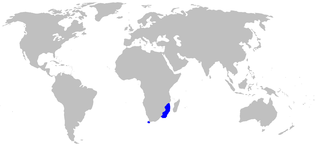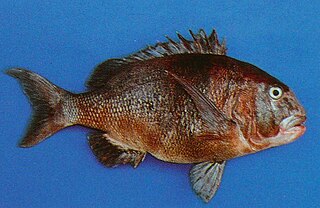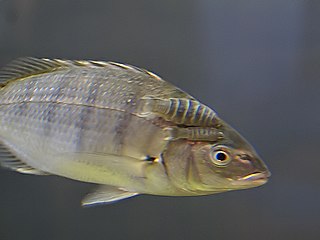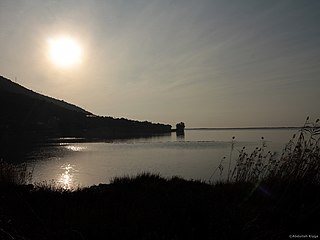
The Sparidae are a family of fish in the order Perciformes, commonly called sea breams and porgies. The sheepshead, scup, and red seabream are species in this family. Most sparids are deep-bodied compressed fish with a small mouth separated by a broad space from the eye, a single dorsal fin with strong spines and soft rays, a short anal fin, long pointed pectoral fins and rather large firmly attached scales. They are found in shallow temperate and tropical waters and are bottom-dwelling carnivores.

Seine fishing is a method of fishing that employs a surrounding net, called a seine, that hangs vertically in the water with its bottom edge held down by weights and its top edge buoyed by floats. Seine nets can be deployed from the shore as a beach seine, or from a boat.

The white-spotted Izak or African spotted catshark is a catshark of the family Scyliorhinidae. It is found in the western Indian Ocean off the coasts of Natal, South Africa, southern Mozambique, Madagascar, Kenya, and Tanzania between latitudes 4° S and 37° S, at depths of between 220 and 440 m. It can grow up to 35 cm in length.

The brown shyshark or plain happy is a species of catshark, part of the family Scyliorhinidae. It is endemic to the shallow, coastal waters of South Africa from west of Cape Agulhas to KwaZulu-Natal. This benthic species is usually found over sandy or rocky bottoms. Measuring up to 73 cm (29 in) long, the brown shyshark is stoutly built, with a broad, flattened head and rounded snout. Unlike other shysharks, the brown shyshark has a plain brown color, though some individuals have faint "saddle" markings or light or dark spots. When threatened, this shark curls into a circle with its tail over its eyes, which is the origin of the name "shyshark". It feeds on bony fishes and lobsters, and is oviparous with females laying pairs of egg capsules. The International Union for Conservation of Nature (IUCN) has assessed this harmless species as Vulnerable. It is of no commercial or recreational interest, but its limited distribution makes its entire population vulnerable to increases in fishing pressure or habitat degradation.

Lithognathus is a marine fish genus in the family Sparidae, members of which are commonly known as steenbras. They are primarily found in coastal regions in Southern Africa, but L. mormyrus also occurs in the Mediterranean Sea, Black Sea, Bay of Biscay and off various islands in the northeast Atlantic. Depending on the exact species involved, they reach a maximum length of between 26 and 200 cm.

Acanthopagrus butcheri, the black bream but also commonly known as the southern black bream, southern bream and blue-nosed bream, is a species of marine and freshwater fish of the porgy family, Sparidae. It is a deep-bodied fish, occasionally confused with other similar species that occur within its range, but is generally distinguished from these species by a lack of yellow ventral and anal fins. Southern black bream are endemic to Australia, inhabiting the southern coast from Shark Bay in Western Australia to Ulladulla, New South Wales, as well as Tasmania.

Acanthopagrus australis, the yellowfin bream, also known as sea bream, surf bream, silver bream or eastern black bream, is a species of marine and freshwater fish of the porgy family, Sparidae. It is a deep-bodied fish, occasionally confused with Acanthopagrus butcheri, but is generally distinguished by its yellowish ventral and anal fins. It is a popular target for recreational fishermen due to its capacity to fight well above its weight coupled with its table quality.

Sarpa salpa, known commonly as the dreamfish, salema, salema porgy, cow bream or goldline, is a species of sea bream, recognisable by the golden stripes that run down the length of its body, and which can cause ichthyoallyeinotoxism when eaten. It is found in the East Atlantic, where it ranges from the Bay of Biscay to South Africa, as well as in the Mediterranean. It has occasionally been found as far north as Great Britain. It is generally common and found from near the surface to a depth of 70 m (230 ft). Males are typically 15 to 30 cm (6–12 in) in length, while females are usually 31 to 45 cm (12–18 in). The maximum size is 51 cm (20 in).

Petrus rupestris is a species of fish in the family Sparidae and the only known member of the genus Petrus. The common name of this species is red steenbras. The species' population has been depleted by overfishing in African waters.

The black musselcracker is a South African species of marine fish in the family Sparidae. It is the only species of its genus Cymatoceps. It reaches 1.5 m in length and almost 35 kg (77 lb) in weight. It is found in coastal rocky areas to depths of 80 m (260 ft), and feeds on hard-shelled invertebrates such as crabs and sea urchins.

Chrysoblephus laticeps, also known as the red roman or roman seabream, is a species of sea bream from southern Africa, ranging from Namibia to the Eastern Cape. There are also old records from Madagascar and Mauritius, but the validity of these is doubtful. This demersal fish grows to a maximum length of 50 centimetres (20 in) and a recorded mass of 4.2 kilograms (9.3 lb). It is a slow-growing species showing late sexual maturity, and is closely related to the Red Stumpnose. It is found above rocky bottoms and reefs, in water up to 100 metres (330 ft) in depth and is often caught from the beach by anglers. Juveniles mature in seaweed beds and feed on mollusks, crustaceans, worms and fish. Adults are benthic feeders, living on crustaceans, sea urchins and polychaete worms.

Rhabdosargus holubi, the Cape stumpnose, is a species of fish in the seabream family, Sparidae. It is native to southern Africa, where it can be found mainly along the eastern coast of South Africa.

The west coast seabream or west coast steenbras is a species of marine fish in the family Sparidae. It is found in very shallow water off the coasts of to Angola, Namibia and South Africa. The International Union for Conservation of Nature lists its conservation status as being "near threatened".

The sand steenbras or striped seabream is a species of marine fish in the family Sparidae. It is found in shallow water in the Mediterranean Sea and in the eastern Atlantic Ocean from France to South Africa. It also occurs in the Red Sea and off the coast of Mozambique in the Indian Ocean. The IUCN has assessed its conservation status as being of "least concern".

Pachymetopon blochii, the hottentot seabream or hottentot, is a species of sea bream in the family Sparidae, native to the southwestern coast of Africa.

Crenidens crenidens, the karanteen seabream or karanteen, is a species of ray-finned fish from the sea bream family Sparidae which was described by the Swedish zoologist Peter Forsskål in 1775. It is native to the western Indian Ocean but has colonised the eastern Mediterranean Sea since 1970. It is one of only three species in genus Crenidens, the others being the little known Crenidens macracanthus and the partially sympatric C. indicus.

Beymelek Lagoon is a lagoon on the Mediterranean coast, which is used as a fishery, in Antalya Province, southwestern Turkey. It is named after the village of Beymelek, which is located to the west of the water body. It is situated in Demre ilçe (district) of Antalya Province at 36°16′N30°03′E.
Sparodon, commonly known as the white musselcracker, musselcracker seabream, mussel cracker seabream, brusher, or cracker. is a monotypic genus of fish in the family Sparidae. The type and only known species, Sparodon durbanensis, was first described and named by François Louis Nompar de Caumont de Laporte, comte de Castelnau, in 1861.
The Helderberg Marine Protected Area is a small marine conservation area on the north-eastern side of False Bay in the Western Cape province of South Africa, It lies between the mouths of the Lourens River in the Strand, and the Eerste River in Macassar.
The Robberg Marine Protected Area is an inshore conservation region in the territorial waters of South Africa, near Plettenberg Bay in the Western Cape province.


















